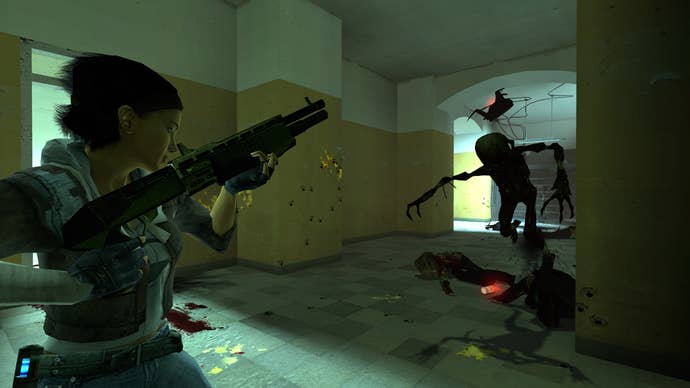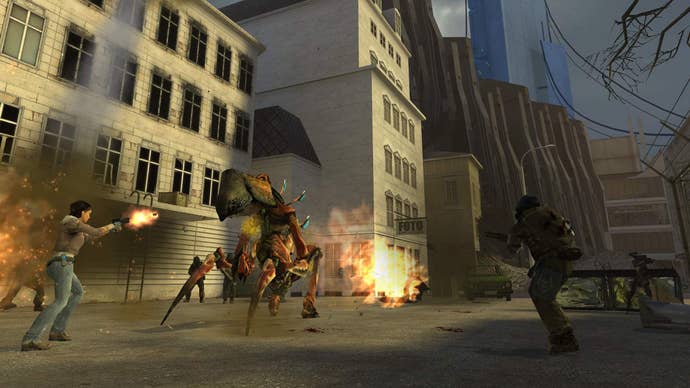10 Years Ago, Half-Life 2: Episode One Began Valve's Biggest Broken Promise
While it set us up for disappointment, this first Half-Life 2 episode remains one of the few treasures from Valve's most interesting era.
This article first appeared on USgamer, a partner publication of VG247. Some content, such as this article, has been migrated to VG247 for posterity after USgamer's closure - but it has not been edited or further vetted by the VG247 team.
On May 24, 2006, Valve announced Half-Life 2: Episode Three—the true finale to 2004's Half-Life 2—would launch in December of 2007. With Episode One just a week away, it seemed as if Valve would finally close the curtain on this acclaimed FPS, and move on to bigger and better things by the time 2008 kicked into gear.
Unfortunately for us, only part of this prediction came to pass. While many wonderful experiments would spawn from the technology and brainpower behind Half-Life 2, its long-awaited final Episode has now taken the role of the Internet's new Duke Nukem Forever joke. But instead of sneering derision towards a misguided IP that had gone stale before Y2K, in the case of Episode Three, the joke is squarely on us. We weren't only robbed of a conclusion that left us hanging; we were also robbed of another experience from Valve's most creative and fruitful era—one they've since left behind to rest on their laurels count their Dota 2 money. (And honestly, who can blame them?)

Back when hope still existed for Half-Life 2, the gaming industry was a very different beast. Steam hadn't come close to capturing its modern ubiquity, and many still regarded the platform as a hijacking of their PCs. And though the sale of boxed PC games were then on the decline, digital sales had not yet become the default. With the iTunes Store and its DRM protection only coming into being a few years prior, consumers were rightfully skeptical over how much they would truly own their digital content years down the road. And, faced with the prospect of losing their customer base entirely, retailers had begun fighting tooth and nail to keep physical game releases viable.
In this turbulent, unpredictable climate of 2006, Valve released Half Life 2: Episode One, which took advantage of its developer's largesse and critical acclaim to test the waters in more ways than one. Not only did this release continue Valve's efforts to double down on Steam; it would also begin their initiative to produce episodic content. PC gaming enthusiasts had experienced a similar style of release in the past with expansion packs, but rather than existing as simply more content bolted onto Half-Life 2, these episodes would be stand-alone—albeit interconnected—experiences. For Valve, this approach seemed ideal: Rather than spending another five to six years on Half-Life 3, episodic content would give them the chance to strike multiple times while the iron was still hot, and prevent the arduous production cycle of Half-Life 2 from ever happening again.
Even as short as 10 years ago, it's interesting to see just how different our priorities were. The value of games still amounted to a length-based proposition, meaning, to some, Half-Life 2: Episode One's three-hour running time was nothing short of preposterous. (Admittedly, $19.99 might have been a little steep, but Valve was clearly in uncharted territory.) It wouldn't take long for our values to shift, but the rise of indie games still had a few years before it could show us an experience could be perfectly satisfying if it ended after just a few hours and left us wanting more. Coincidentally, Valve's own Portal would bring this revelation to the world a little over a year later: Much of its buzz centered on how it defied conventional wisdom with the power of brevity.

Episode One could have never had the same impact as 2004's Half-Life 2, but Valve still used it as the testing ground for some pretty impressive tech. While its visuals definitely feel more modern than its predecessor thanks to a better lighting engine, Episode One's biggest feature could be found front and center on the box—or the Steam cover art—in the form of Alyx. While Half-Life 2 experimented with AI by giving you slightly dull squad mates to give simple commands, Episode One pairs you alongside a fairly bright computer-controlled Alyx Vance for most of the adventure. While her constant presence did a good job of highlighting protagonist Gordon Freeman's complete lack of humanity, Alyx's competence felt like a true achievement—one game developers had been chasing for quite some time.
In retrospect, the early sections of Episode One underline how uninterested Valve was in just making another FPS. The gravity gun—without a doubt, Half-Life 2's highlight—serves as Gordon's first weapon, and much of the beginning entails using it and only it to solve environmental puzzles. These segments build so well off of the gravity gun puzzles of Half-Life 2, you get the feeling Valve would have turned Episode One into Gravity Gun: The Game if they could have gotten away with it. In comparison, combat set pieces like an underground, flashlight-lit battle with waves of zombies certainly stand out, but much of the traditional run-and-gunning can't help but feel like filler. Even before Episode 2's release, it's easy to get the sense that Valve is struggling to come up with worthwhile ideas that fit within the context of Half-Life 2.

Honestly, that seems to be why they've left the series behind. The central ideas present in Valve games to follow could have easily been explored further in Half-Life Episodes, but became much more fruitful when developed into their own things. From a 2016 perspective, Alyx's AI feels like a prototype for the computer brain bringing life to the Left 4 Dead world, and Half-Life 2's first-person puzzles definitely paved the way for Portal and its sequel. And, at the risk of sounding blasphemous, Half-Life 2's story might not be worth concluding in the first place. The narrative does its job and certainly sets up an enthralling atmosphere, but Half-Life's overarching plot contains few principal primary characters, even fewer meaningful events, and an embarrassing amount of deus ex machinas. Truly, the best story in Half-Life 2 is the one left unspoken: the bleak history of the world told through the evocative depiction of its environments.
Even if Valve will never deliver on the promise established by Half-Life Episode One, this game and its follow-up feel less like wasted potential these days, and more like treasures from an era of the developer we'll likely never see again. Ultimately, though, it feels as if no conclusion could ever be satisfying: Valve left behind the narrative-focused, single-player FPS shortly after perfecting it, and the sheer amount of games Half-Life 2 has influenced in the passing decade would only make any potential Episode 3 feel derivative. The sense of lingering disappointment may persist a whole decade later, but an unsatisfying end to Half-Life 2 would be nothing short of a tragedy.








